Worried that his eyes and urine were turning a deep yellow, Gednezar Dladla made his way to a local clinic and was referred to a district hospital, where he was x-rayed, diagnosed with gallstones, and admitted for the night. Both institutions receive funding from the Wellcome Trust and the Bill & Melinda Gates Foundation.
A day later, Dladla set off through the hills and valleys of rural Zululand to a village near his childhood home, where a group of men played cards in the shade of a tree. The environmental activist listened to their grievances about dust pollution, water shortages and lack of assistance from a local mine owned by Rio Tinto – whose investors include the Wellcome Trust and the Bill & Melinda Gates Foundation.
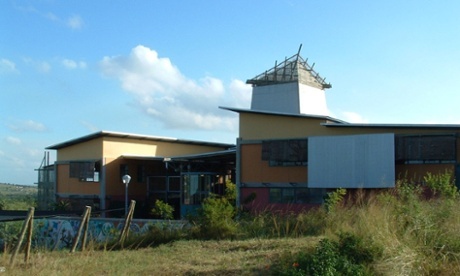 Africa’s health centre at the frontline of HIV research
Africa’s health centre at the frontline of HIV research
Two of the greatest philanthropic organisations in the world, responsible for saving countless lives through scientific research and healthcare programmes, are heavily invested in fossil fuel industries that have profound impacts on the health of local communities and cause climate change. Nowhere is this paradox more acute than in South Africa, a country with the biggest HIV caseload in the world and an economy founded on mining.
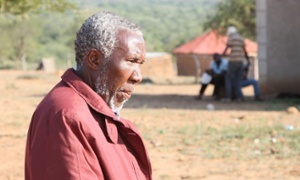
Facebook Twitter Pinterest
Gednezar Dladla, 60, campaigns for people living around the mining areas in northern KwaZulu-Natal. Photograph: Khaya Ngwenya/Demotix for the Guardian
“I would absolutely recognise that it’s a very difficult decision for big funders like the Wellcome Trust and Gates Foundation: they need to manage their investments in the best way possible to maximise funding for research,” said Marie-Louise Newell, former director of the Africa Centre for Health and Population Studies, which receives money from both to combat HIV. “But if you think back to apartheid days, there are times when you need to make big statements, and the climate change issue is very worrying.”
The Africa Centre is located in the beautiful KwaZulu-Natal province, where one in three people have HIV and – around the town of Mtubatuba, 173 miles north of Durban – a 15-year-old girl has an 80% chance of contracting it in her lifetime. Inside its modern building, which has won architecture prizes, are staff in T-shirts and jeans processing data on laptops.
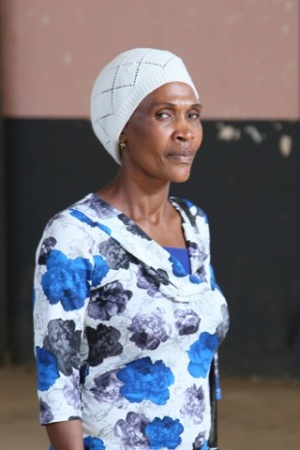
Facebook Twitter Pinterest
Zanele Zungu, 43, who has HIV and TB, collects her medication from Hlabisa hospital, in northern KwaZulu-Natal. Photograph: Khaya Ngwenya/Demotix/for the Guardian
In a poverty-stricken area where joblessness is estimated at 70%, the Africa Centre is one of the three biggest employers. It does vital work supporting healthcare for local people and receives up to £4m a year from the Wellcome Trust and contributions from donors including the Gates Foundation for world-class HIV and tuberculosis research. The list of papers published by the centre’s researchers in scientific journals numbered 99 last year alone. The centre works in lockstep with the South African government and provides advice, expertise and training to Hlabisa district hospital and 17 associated primary care clinics.
At the hospital earlier this month, half a dozen patients wearing face masks sat on plastic chairs outside a prefab structure, awaiting the free TB medication that keeps them alive. Among them was Zanele Zungu, 43, who was diagnosed with TB and HIV in 2003, the same year her 34-year-old husband, Sipho, died of Aids. “The passing of my husband was shocking to me,” the mother of five recalled through a Zulu interpreter, a tear on her cheek.
“I was very scared because I had the same symptoms my husband died of. He had sores on the mouth and all over the body. He used to scream a lot in his last days. He was feeling a lot of pain, and that’s why I took him to hospital. There was no treatment at that time and he passed away.”
Zungu, who walks for an hour from her mudbrick home to reach the hospital, was unaware that it is supported by the Africa Centre – or that its benefactor, the Wellcome Trust, invests in the mining industry. “I would like to say thank-you because they provide life to us. That’s why we are alive. But investing in a mine is not right … They must only give to the hospitals, because people are dying every day.”
Newell’s successor, Prof Deenan Pillay, said: “The aim of the Africa Centre is to do world-class science and the Wellcome Trust is one of the major and most prestigious funders of science. As such I’m very happy to receive Wellcome Trust resources for that because it brings a reputation for high quality of research.”
On the Wellcome Trust’s investment policies, he added: “Climate change and energy use are some of the most pressing global issues, and I welcome the debate on the impact of investment policies. I recognise the variety of views within this debate.”
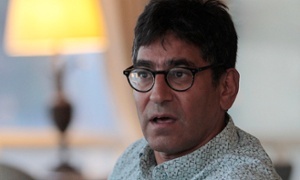
Facebook Twitter Pinterest
Deenan Pillay, 57, director of the Africa Centre. Photograph: Khaya Ngwenya/Demotix for the Guardian
South Africa has the deepest mines in the world and the industry employs half a million people. But nature’s blessing of coal, diamonds, gold and platinum has also been a curse over the past century and a half. Thousands of workers have died in accidents. Continual exposure to mineral dust in mine shafts has resulted in high rates of silicosis. That, and the proximity of mineworkers underground, contributes to the spread of TB. In South Africa’s mines the disease is up to six times more common than in the general population. Men in a mining area tend to attract commercial sex workers, leading to the spread of HIV. Scientists are studying the potential dangers of acid draining from disused mines into water supplies.
Coal is the dirtiest of fossil fuels and soot and dust emissions from coal burning are, along with diesel engines, the biggest contributors to microscopic particulate pollution that penetrates deep into the lungs. This causes heart attacks and lung cancer as well as increasing asthma attacks and other respiratory problems. A 2013 study found that air pollution from Europe’s 300 largest coal power stations causes 22,300 premature deaths a year and costs companies and governments billions of pounds in treatment and lost working days.
Dladla, a retired cattle herder who is married and has three sons, wears a faded T-shirt that reads: “Remember the slain of Marikana,” – a reference to the 2012 police massacre of 34 striking mineworkers. He sits on the steering committee of the Mining and Environmental Justice Community Network of South Africa.
Looking out from a car as it bumped slowly towards the Zululand Anthracite Colliery (ZAC) near the town of Ulundi – about 25 miles (40km) from the Africa Centre – Dladla sighed. “The trees are full of dust, the grass is full of dust. It will have to rain a lot for the grass to be washed, for the leaves to be washed. It has become the life people are living here: they are living in dust every day.” A billboard proclaims the town to be “the core of the Zulu heritage”.
Soon a giant discarded dump emerged into view from the countryside, along with the vast cranes and machinery of a processing plant where cows grazed nearby. It produces anthracite, a relatively clean coal, which the mine’s owner, Rio Tinto, sends to provide raw material for its Richards Bay mine on the coast.
Inside, a poster announced: “Rio Tinto. Speak out. Doing what’s right.” Rio Tinto is a leading international mining giant in which the Wellcome Trust and Gates Foundation have invested $157m (£100m) and $10m respectively. The Guardian’s Keep it in the Ground campaign is calling for both charities to move their investments out of fossil fuel companies, including Rio Tinto.
Advertisement
The company bought the ZAC in 2011, inheriting a troubled history that included the digging of three mine shafts without environmental authorisation, for which Rio Tinto last year paid a cursory fine.
People in the village of Okhukho, which is virtually surrounded by the mine, are critical of its side effects. Sitting under a tree with a group of jobless men playing cards, Thembinkosi Zulu, 20, a student, said: “There are a lot of trucks and they are never sealed. I’ve got sinus problems from inhaling the dust. My nose gets blocked and painful. The mine must cover the trucks and water the roads. The mine does create jobs, but they don’t attend to the community’s needs adequately.”
Xolani Majola, 23, who lives next to the road used by trucks around the clock, said his brothers, aged 10 and nine, were constantly coughing and complaining about chest pains. “When your clothes are on the washing line, by the time you come back, they’ll be all dusty. If you sleep with your window open, you’ll be dusty yourself. With the noise, you find it hard to sleep.”
Lindekile Mncube, 26, added: “There is dust when they haven’t watered the roads. The dust makes it difficult for us to breathe and it falls on our curtains. I’m worried about the effect on our lives here, but there’s nothing I can do.”
Mining consumes huge quantities of water and the ZAC draws it from the local Umfolozi river, a vital source for the community and its livestock. Mncube said: “We’ve been complaining about water, but the mine has done nothing. When the mine came, we thought we would get everything we need.”
Lungile Ngqulunga, 54, also mentioned a lack of water as she leaned against her front step with her 15-month-old grandson, Kusile. A nearby bowl crawled with flies as goats wandered by and cockerels sang cock-a-doodle-doo. Her husband was away, she explained, receiving treatment for TB that he contracted a decade ago while working at the ZAC.
“We don’t have water,” Ngqulunga complained. “The river has been suffering ever since the mine started working. One of the pipes from the mine burst and now we’re scared of going to the river. There are no taps in this area and we struggle for drinking water. We ask the mine for water and they say we must go to the government. We go to steal it inside the mine, but if the security guards catch you, you will be locked up.”
The ZAC denies polluting the river or the air and says it is helping local villages. David Outhwaite, a London-based spokesman for Rio Tinto, said: “The Zululand region as a whole, and Okhuko community in particular, has been adversely affected by a severe drought being the worst in many decades. ZAC supplies in excess of 40m litres of potable water free of charge at various strategic water points in the community close to our operations. ZAC is not in a position to supply water to every one of the 80,000 people living in the rural community surrounding the mine.”
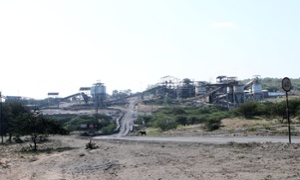
Facebook Twitter Pinterest
Zululand Anthracite Colliery (ZAC) near Ulundi. It is owned by the mining giant Rio Tinto. Photograph: Khaya Ngwenya/Demotix for the Guardian
Responding to complaints about dust, he said: “All trucks transporting final product from the plant area to the siding are covered with tarpaulins. The coarse size of the run-of-mine product from the shafts to the plant does not necessitate the covering of those trucks. Dust generated by vehicles, both our own and others, on the public gravel roads is actively managed by ZAC on a daily basis through an extensive dust suppressing programme.” Rio Tinto did not respond to questions about TB.
A Wellcome Trust spokesperson said: “When managing the investment
portfolio that funds our mission, we consider companies’ social and
environmental responsibilities carefully and engage to encourage them
to take these seriously. We do not comment on individual companies.”
A spokesperson for Bill Gates’s private office said: “Bill and Melinda Gates wrote in their recent annual letter that ‘the long-term threat [of climate change] is so serious that the world needs to move much more aggressively – right now – to develop energy sources that are cheaper, can deliver on demand, and emit zero carbon dioxide.’ Bill is privately investing considerable time and resources in this effort and the breakthrough innovations needed and will continue to speak out about it. We respect the passion of advocates for action on climate change, and recognise that there are many views on how best to address it.”
But setting off for home, Dladla was convinced he had experienced the sharp end of a contradiction involving two of the world’s leading givers. It did not add up. He demanded: “[They] must stop investing in these mines because the mines are making people suffer while the management enrich themselves … They should divest.”

